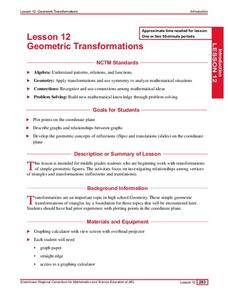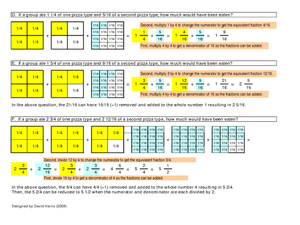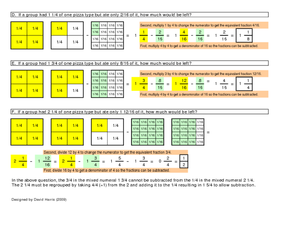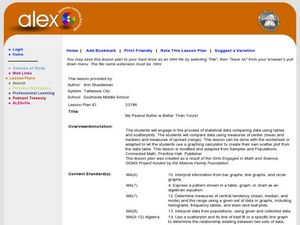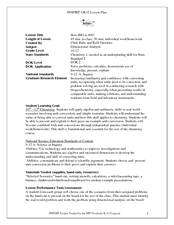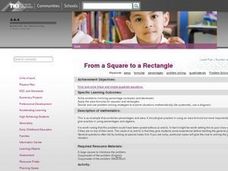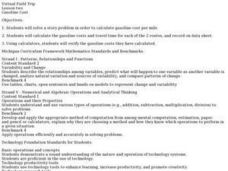Curated OER
Ten in the Bed
First graders share the story "Ten in the Bed". They rewrite the story so that the initial character is calling others to bed. There was one in the bed and the little one said, "Come to bed, come to bed." There were two in the bed and...
Curated OER
Virtual Field Trip: Lodging and Meals
Learners calculate the costs for lodging and meals for a virtual field trip. They calculate the number of nights lodging needed for road and city travel and the number of meals needed, the costs for each, and input the data using...
Curated OER
Geometric Transformations
Learners solve problems involving transformations of geometric figures. They review graphing points in the coordinate plain, plot points and connect to create a triangle. Then, they reflect triangles over the x and y axis and use...
Curated OER
Advanced Adding Fractions
In this adding fractions worksheet, learners read about the process of adding fractions, examine some sample problems, and then solve 4 problems independently.
Curated OER
Advanced Subtracting Fractions
In this subtracting fractions learning exercise, students read about the process of subtracting fractions, examine some sample problems, and then solve 4 problems independently.
Curated OER
Advanced Dividing Fractions
In this advanced dividing fractions worksheet, 5th graders solve 5 dividing fractions problems with diagrams to create a pattern of solving this type of problem.
Curated OER
My Peanut Butter is Better Than Yours!
Students explore the concept of statistical data. In this statistical data lesson, students read an article about the dangers of peanut butter to those who are allergic. Students perform a taste test of two different brands of peanut...
Alabama Learning Exchange
Ellipse
Students explore the concept of ellipses. In this ellipses lesson, they construct ellipses on their paper and follow directions on a worksheet that allow them to investigate an ellipse in more depth by looking at the major axis, foci, etc.
Alabama Learning Exchange
Properties of Minerals
High schoolers explore the basic building blocks of our planet. In this minerals lesson students begin the process of forensics on the basis of investigation and drawing conclusions from observations.
Alabama Learning Exchange
Factoring by Mack
Learners explore the concept of factoring trinomials. In this factoring trinomials activity, pupils use the Mack Method to factor trinomials. Learners watch a video on how to factor a trinomial with a coefficient of 1 with...
Alabama Learning Exchange
Writing Word Equations
High schoolers explore the concept of chemical formulas. In this chemical formula lesson, students watch a video about balancing chemical equations. High schoolers conduct an experiment using silver nitrate and sodium...
Curated OER
Water: On the Surface and in the Ground
Pupils explore the differences between surface water and ground water. They collect data using maps and graphs and investigate a Texas river basin and a nearby aquifer. They complete a written report including maps and data regarding the...
Curated OER
A Pocketful of Change
Students study the meaning, symbolism, and value of U.S. coins,
especially the quarter. They conduct a survey of coins in students'
possession, graphing the results to show frequency distribution and drawing
inferences about the U.S....
Alabama Learning Exchange
Explore the Transformations of Linear and Absolute Value Functions Using Graphing Utilities
Students explore the concept of transformations. For this transformation instructional activity, students use an applet that is an interactive absolute value graph applet. Students manipulate the applet to examine the change...
Curated OER
Water-Is There Going to be Enough?
Students research the availability, usage and demand for water in the local area historically and use projections of the availability, usage and demand for water up to the year 2050. They gather data and present the information in...
Curated OER
Toothpick squares
Young scholars state the general rule for a practical situation. They describe a continuing pattern. They use toothpicks to help visualize the problem and answer it correctly.
Curated OER
How BIG is 400?
Students solve problems using dimensional analysis. In this chemistry lesson, students choose a problem and present it in class. The rest of the class will evaluate the solved problem on the board.
Curated OER
Bubble Gum Chemistry
Students explore the concept of graphing data. In this graphing data lesson, students determine the percentage of sugar in bubble gum. Students graph type of gum vs. sugar percentage. Students create a table of their data.
Curated OER
It's a Party! Solving Multi-step Equations
Students explore the concept of multi-step equations. In the multi-step equation lesson, students solve equations by the 'party method'. Students make a flip book that shows the steps in solving multi-step equations.
Alabama Learning Exchange
The Composition of Seawater
Students explore the concept of finding the composition of seawater. In this finding the composition of seawater instructional activity, students make a saturated salt water solution. Students discuss why there is variation...
Curated OER
Pumps
Students examine the basic types of pumps. They build a gravity-driven water pump and solve a mystery using their knowledge of pressures and pumps.
Curated OER
National Symbol Patterns
Students discuss and create their own patterns. They practice and improve on making patterns of their own using red, white, and blue paper for a national theme. The symbols are based on what the teacher picks for the class.
Curated OER
From a Square to a Rectangle
Eighth graders solve problems involving percentage increases and decreases. Using given percentages, 8th graders transform a square into a rectangle. They apply the area formulas for squares and rectangles.Students observe the percent...
Curated OER
Virtual Field Trip/ Gasoline Cost
Students complete a word problem to determine the cost of gasoline per mile of their virtual field trip. They determine the travel time and gasoline costs for two routes and record the information on a data sheet. They check their work...


